Step-by-Step Guide to Recover Old Email Accounts
Have you ever wondered what **old email accounts** might still hold for you? It’s time to uncover the possibilities! Not only could these accounts carry fond memories, but they might also unlock hidden opportunities that you’ve forgotten about. Let’s dive into how maintaining these accounts can be beneficial.
Remember that email from years ago with an important attachment? Or perhaps there was an email confirmation for a service you’ve overlooked? **Old email accounts**, often seen as clutter, can actually house valuable information crucial for both your personal and professional life.
Instead of ignoring these old emails, why not explore them for insights or forgotten gems? In this article, we’ll examine practical security tips, benefits of accessing archived messages, and strategies to keep your old emails organized without stress.
Why Maintain Old Email Accounts
Old email accounts might seem like digital clutter, but they often hold untapped potential. These accounts can store a wealth of information, from sentimental communications to crucial documents, that you may need to reference later. Keeping these accounts active ensures that you can always go back and retrieve important messages.
Preserving Digital History
Old emails serve as a digital timeline, recording important events and communications throughout your life. Whether it’s receipts for online purchases or sentimental correspondence, maintaining these accounts helps preserve your digital history in an organized fashion.
Access to Critical Information
There might be times when you need to find a specific piece of information, such as a password reset email or an invoice. Old email accounts can provide access to this critical information, saving you the hassle of searching through paper documents or multiple digital locations.
Managing Subscriptions and Services
Many people use email accounts to subscribe to newsletters or services. By keeping old accounts, you can manage these subscriptions more effectively, ensuring you stay updated on important updates or changes to services you utilize regularly.
Beyond their archival value, keeping these accounts active and secure is crucial to protecting your digital footprint from unauthorized access. Using access controls like strong passwords and two-factor authentication will help protect your data as you continue to keep these accounts.
Benefits of Accessing Archived Emails
Accessing archived emails offers numerous advantages that can simplify and enhance your digital life. These emails act as a reliable record of communication, providing a detailed history of important conversations and decisions. Keeping these records helps ensure that you have evidence of past agreements or discussions if needed.
Archived emails can be a treasure trove of valuable information. They might contain crucial details such as contact information, login credentials, or even creative ideas you once exchanged. Re-visiting these emails can provide insights or help you rediscover useful resources you had forgotten.
Streamlining Work Processes
For professionals, accessing archived emails can improve efficiency by allowing you to reference past projects, timelines, or feedback without the need for additional meetings. This can be particularly useful for long-term projects where continuity and context are essential.
Efficient Information Retrieval
With effective organization, archived emails can be easily searched and accessed. Using specific keywords or filters, you can quickly retrieve vital information without sifting through hundreds of unrelated emails. This makes it simple to find exactly what you need, when you need it.
Overall, maintaining access to your archived emails turns them into a powerful resource. They provide continuity in communication, preserve valuable knowledge, and contribute to well-informed decision-making processes.
Security Tips for Old Email Accounts
Maintaining the security of old email accounts is crucial to protecting your digital information from unauthorized access. One effective way to do this is by using strong passwords. Create a complex password with a combination of letters, numbers, and symbols. Avoid using easily guessed information like birthdays or common words.
Enable Two-Factor Authentication
Two-factor authentication (2FA) provides an extra layer of security. When enabled, it requires not only your password but also a second form of verification, such as a code sent to your phone, to access your account. This makes it much harder for unauthorized users to gain entry.
Regular Account Monitoring
It’s important to regularly monitor your old email accounts for any suspicious activity, like unexpected login attempts. Most email providers offer a log of recent sign-ins, which you can check for any unauthorized access. If you notice anything unusual, change your password immediately.
In addition, keep all your associated recovery information up-to-date. Ensure that your recovery email and phone number are current, so you can quickly regain access if needed. Taking these steps will help keep your old email accounts secure without hassle.
Organizational Strategies for Old Emails
Organizing old emails might seem daunting, but implementing a few strategies can make the process manageable and efficient. Start by using folders or labels to categorize your emails. Create categories like ‘Work,’ ‘Personal,’ ‘Receipts,’ and ‘Newsletters’ to keep things organized. This way, you can access the information you need without digging through an entire inbox.
Utilize Filters and Rules
Most email services allow you to set up filters or rules that automatically sort incoming emails. By using filters, you can automatically file emails into specific folders based on criteria like sender, subject, or keywords. This automated approach ensures your inbox remains tidy without constant manual intervention.
Regular Cleanup
Dedicate time weekly or monthly to go through your old emails. This involves deleting unnecessary messages and moving important ones to their designated folders. Use the search function to find and delete old newsletters or promotions you no longer need, freeing up space and reducing clutter.
Backup is another crucial element in organizing old emails. Regularly back up important emails to a secure location, such as an external hard drive or cloud service, to prevent data loss. Employing these strategies will help keep your old emails organized, accessible, and safe.
FAQ – Frequently Asked Questions About Old Email Accounts
Why should I keep old email accounts active?
Keeping old email accounts active allows access to important data and communications, preserving your digital history and ensuring information is readily available.
How can I secure my old email accounts?
Use strong passwords and enable two-factor authentication to enhance security. Regularly monitor account activity for signs of unauthorized access.
What are the benefits of accessing archived emails?
Archived emails can provide valuable insights, access to past communications, and important data that might be needed for future reference.
How do I organize old emails efficiently?
Utilize folders, labels, filters, and rules to categorize and sort emails, keeping your inbox tidy and making it easier to retrieve information.
What should I do if I find suspicious activity on an old email account?
Immediately change the password and check recent account activity. Consider notifying your email provider if you suspect a security breach.
How often should I back up my old emails?
Regularly backing up important emails, such as monthly or quarterly, can help prevent data loss and ensure essential information is saved.






